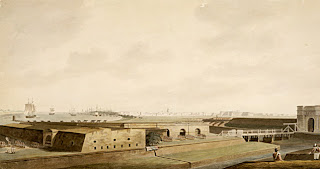William Hodges toured India
extensively between the years
1780 and 1783, having
accompanied Captain Cook on
his second voyage to the
Pacific. Hodges prepared drawings and watercolours for
his engravings, including
'Select views of Calcutta'. This
painting is the first
topographical view of the city,
depicting the initial impression travellers would have seen as
they sailed up the river Hooghly
to approach the `City of Palaces'.
Titled 'A View of Calcutta Taken from Fort William', the picture
displays hallmarks of the classical Picturesque as represented by its
balanced composition, harmonious colours and tranquil atmosphere.
Pictures by Hodges often capture unique effects of light, a fleeting
moment when fading sunlight illuminates particular buildings or
landscape features. His 'View of Calcutta from Garden House Reach',
for example, portrays dark monsoon clouds about to sweep across the
sky above the Hooghly River, calm and milky white as if before a
storm, a striking atmospheric phenomenon that Hodges must have
witnessed many times. Other pictures are almost theatrical, containing
dramatic representations of landscape features and buildings. His
sweeping panoramic views dominated by broad skies and peopled with
tiny figures to enhance the sense of scale, often contain isolated
tombs, lone palm trees, or crumbling ruins.
Other prominent landscape oil
paintings are by Thomas Daniel and his nephew William. The sketches of
Calcutta's palaces and roads in black & white are by western painters
of late eighteenth century came to Calcutta. --
A. B.
extensively between the years
1780 and 1783, having
accompanied Captain Cook on
his second voyage to the
Pacific. Hodges prepared drawings and watercolours for
his engravings, including
'Select views of Calcutta'. This
painting is the first
topographical view of the city,
depicting the initial impression travellers would have seen as
they sailed up the river Hooghly
to approach the `City of Palaces'.
Titled 'A View of Calcutta Taken from Fort William', the picture
displays hallmarks of the classical Picturesque as represented by its
balanced composition, harmonious colours and tranquil atmosphere.
Pictures by Hodges often capture unique effects of light, a fleeting
moment when fading sunlight illuminates particular buildings or
landscape features. His 'View of Calcutta from Garden House Reach',
for example, portrays dark monsoon clouds about to sweep across the
sky above the Hooghly River, calm and milky white as if before a
storm, a striking atmospheric phenomenon that Hodges must have
witnessed many times. Other pictures are almost theatrical, containing
dramatic representations of landscape features and buildings. His
sweeping panoramic views dominated by broad skies and peopled with
tiny figures to enhance the sense of scale, often contain isolated
tombs, lone palm trees, or crumbling ruins.
Other prominent landscape oil
paintings are by Thomas Daniel and his nephew William. The sketches of
Calcutta's palaces and roads in black & white are by western painters
of late eighteenth century came to Calcutta. --
A. B.










Comments